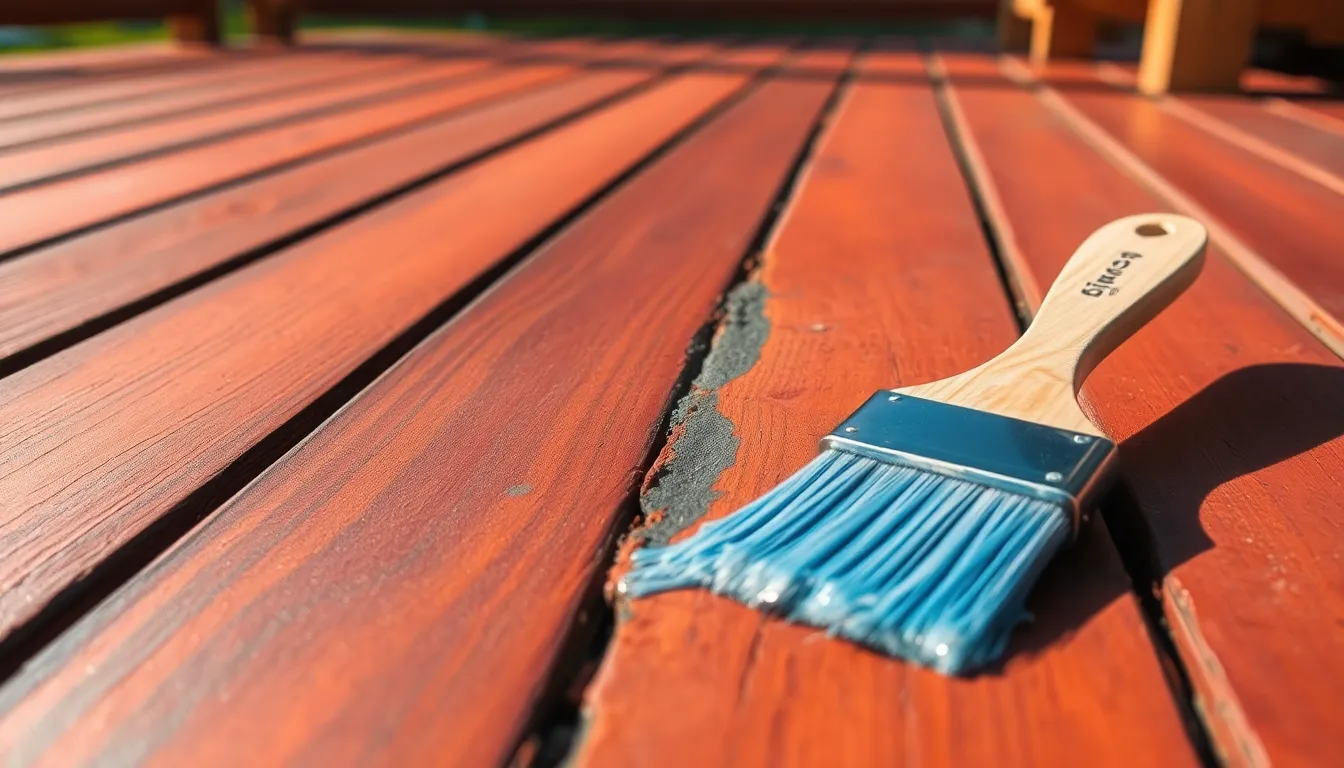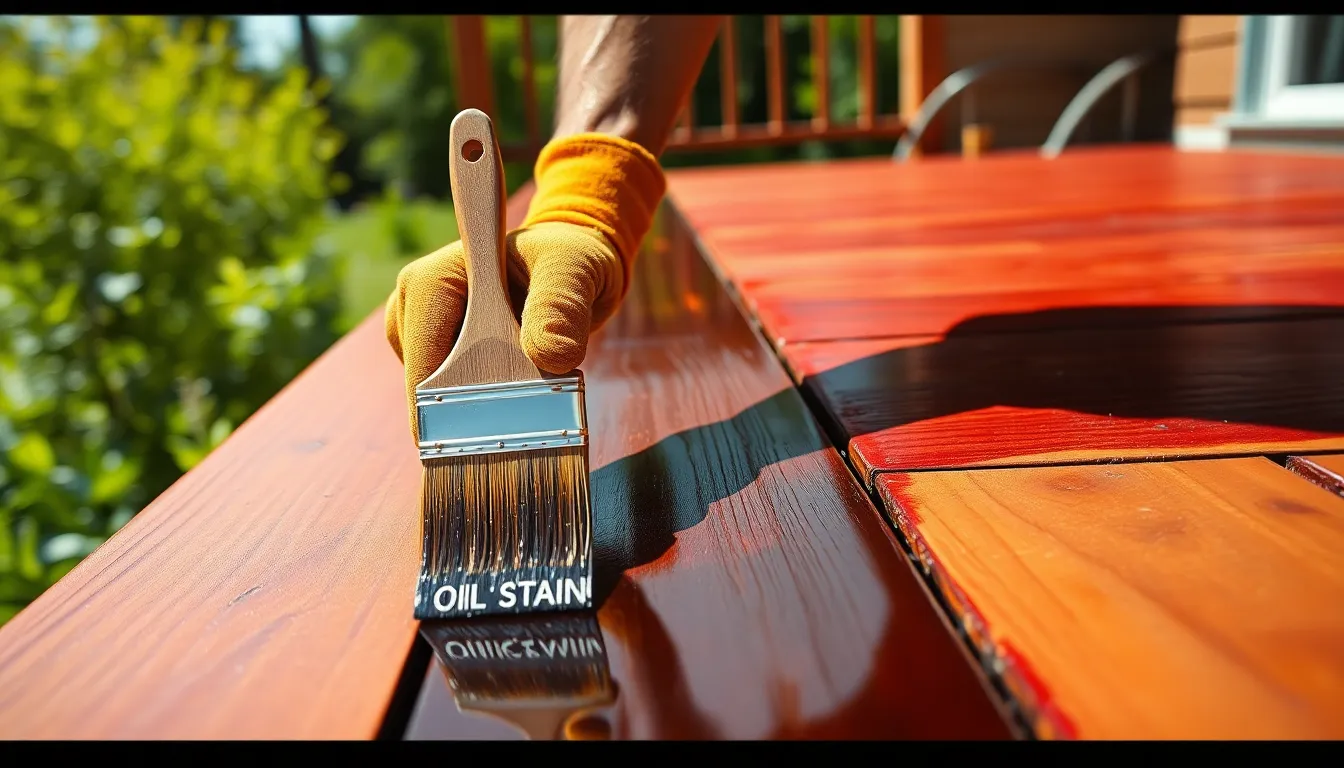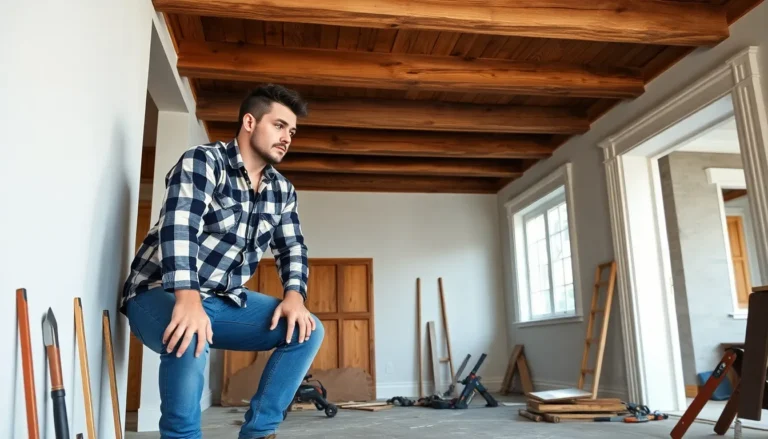Table of Contents
ToggleDeck staining is more than just a cosmetic upgrade; it’s a vital step in preserving the beauty and longevity of outdoor spaces. Over time, decks can suffer from the elements, leading to faded colors, splintered wood, and unsightly mildew. By applying a quality stain, homeowners not only enhance the deck’s appearance but also protect it from moisture and UV damage.
Choosing the right stain and application method can seem overwhelming, but understanding the basics can make the process easier. Whether it’s a fresh coat or a re-stain, knowing how to prepare and maintain a deck can transform it into a stunning outdoor retreat. With the right approach, deck staining can rejuvenate any outdoor space, inviting friends and family to enjoy the beauty of nature in style.
What Is Deck Staining?
Deck staining involves applying a protective and aesthetic finish to wooden decks, enhancing their appearance and longevity. This process shields decks from environmental damage while preserving their structural integrity.
Benefits of Deck Staining
- Protection from UV Rays: Stains often contain UV blockers that prevent sun damage, reducing fading and maintaining color vibrancy.
- Moisture Resistance: Quality stains penetrate wood, creating a barrier against water, which leads to reduced risk of rot and mold.
- Enhanced Aesthetic Appeal: Staining accentuates the natural beauty of wood grains, adding depth and richness to the deck’s appearance.
- Extended Lifespan: Regular maintenance through staining can significantly increase the lifespan of the deck, protecting it from deterioration over time.
- Improved Safety: Non-slip stains can enhance traction, reducing the risk of slips and falls in wet conditions.
Types of Deck Stain Products
- Transparent Stains: These highlight the wood’s natural grain while providing minimal color. Ideal for new or well-maintained decks.
- Semi-Transparent Stains: These offer a balance, providing some color while still showcasing the wood grain. Suitable for decks that show slight wear.
- Solid Color Stains: These provide maximum coverage, concealing imperfections and offering long-lasting color. Useful for older or heavily weathered decks.
- Oil-Based Stains: Known for deep penetration and durability, oil-based products often provide a richer finish but require longer drying times.
- Water-Based Stains: Quick-drying and less odoriferous, water-based stains are easier to clean up and environmentally friendly but may need more frequent application.
Choosing the Right Deck Stain


Choosing the appropriate deck stain involves understanding various factors that influence performance and aesthetics. A thorough assessment of specific needs can aid in selecting the best product for long-lasting results.
Factors to Consider
Durability: Assess the expected lifespan and wear resistance of the stain. Some stains last longer than others, especially in high-traffic areas.
Climate: Evaluate climate conditions such as humidity, rainfall, and sun exposure. Stains suitable for humid areas may differ from those designed for sun-drenched spaces.
Deck Material: Consider the type of wood in the deck. Different woods react uniquely to stains, affecting absorption and finish.
Color Preference: Choose a color that complements the home’s exterior and surrounding landscape. Match aesthetics with functionality.
Maintenance Needs: Understand the maintenance frequency required for each stain type. Some stains necessitate reapplication every few years, while others can last longer.
Comparing Oil-Based vs Water-Based Stains
Oil-Based Stains:
- Penetration: Oil-based stains penetrate deep into the wood fibers, offering improved protection against moisture.
- Durability: Typically, oil-based stains boast greater longevity and resistance to wear and tear.
- Finish: They provide a richer, more vibrant color and enhance wood grain visibility.
- Drying Time: Longer drying times may extend application time, often requiring up to 24 hours before foot traffic.
- Environmental Impact: Water-based stains emit fewer volatile organic compounds (VOCs), making them a more environmentally friendly option.
- Drying Speed: Fast-drying properties allow for quicker application and recoating, often within 2 to 4 hours.
- Color Range: Available in a wide range of colors, water-based stains allow for diverse design options.
- Maintenance: Generally, they require more frequent reapplication than oil-based options, but some modern formulations improve longevity.
Preparing Your Deck for Staining
Preparing the deck is essential before applying any stain. A clean, well-maintained surface ensures optimal adhesion and longevity of the finish.
Cleaning Your Deck
Cleaning the deck removes dirt, debris, and old sealant to create a suitable base for the stain. Use a broom to sweep away loose particles. For stubborn grime, a mixture of water and mild detergent helps effectively clean the surface. A pressure washer can also assist, but maintain a distance of at least 12 inches to avoid damaging the wood. After cleansing, allow the deck to dry completely, which can take 24 to 48 hours, depending on humidity and temperature.
Repairing Damaged Areas
Repairing damaged areas prevents further deterioration and promotes a smooth application of stain. Inspect for any loose boards, splinters, or cracks. Replace any severely damaged boards. Fill small cracks and holes with a suitable wood filler, and sand the repaired areas to ensure a uniform surface. Pay special attention to railings and steps, as these areas undergo more wear and tear. This attention to detail enhances the overall appearance and extends the lifespan of the stained deck.
Application Techniques for Deck Staining
Effective application techniques play a pivotal role in achieving a long-lasting and attractive finish during deck staining. Utilizing the appropriate tools and following a detailed process ensures optimal results.
Tools and Equipment Needed
When preparing for deck staining, several essential tools and equipment are necessary:
- Stain applicator: A roller or brush suitable for the stain type helps achieve a uniform application. A pad applicator may also be used for larger surfaces.
- Paint tray: A tray holds the stain for easy access and efficient application.
- Drop cloths: Placing drop cloths helps protect surrounding surfaces from spills and drips during the staining process.
- Ladder: A ladder provides access to elevated deck areas, ensuring even application across all surfaces.
- Safety gear: Gloves, goggles, and a respirator protect against chemicals and fumes encountered during staining.
- Pressure washer or deck cleaner: These tools effectively clean the deck and remove residue before application, ensuring proper adhesion.
Step-by-Step Staining Process
Following a systematic step-by-step process optimizes the effectiveness of deck staining:
- Preparation: Ensure the deck is dry and free of debris. Inspect the boards for damage and make necessary repairs before cleaning.
- Cleaning: Use a pressure washer and a mild detergent to remove dirt, mildew, and old sealant. Allow the deck to dry completely for 48 hours.
- Testing the stain: Apply a small amount of stain to an inconspicuous area to gauge color and appearance before proceeding with the entire deck.
- Staining: Start at one end of the deck, applying the stain evenly. Work with the grain of the wood to prevent streaks. Apply the stain generously but avoid puddling.
- Second coat: After the first coat dries according to the manufacturer’s instructions, assess if a second coat is necessary. If so, apply it following the same technique.
- Drying: Allow the stain to dry completely, typically for 24 to 48 hours, depending on weather conditions and product specifications. Ensure adequate ventilation during this period.
By adhering to these techniques, homeowners can achieve a stunning and durable deck finish that enhances the outdoor space’s appeal.
Maintenance Tips for Stained Decks
Maintaining stained decks ensures their beauty and durability over time. Regular care and timely reapplication of stain contribute significantly to preserving the deck’s integrity.
Regular Cleaning and Care
Regular cleaning promotes the longevity of stained decks. Homeowners should sweep debris away weekly to prevent mold and mildew buildup. They can use a mixture of warm water and mild detergent for monthly cleaning. For tough stains, a soft-bristle brush helps lift dirt without damaging the wood. Rinsing thoroughly with water after cleaning is vital to remove soap residue. During rainy seasons, checking for standing water and clearing it promptly prevents moisture damage. Applying a mold and mildew cleaner to problem areas can enhance the appearance and safety of the deck.
Reapplication Guidelines
Reapplication of deck stain enhances protection and aesthetics. Homeowners should reapply stain every one to three years, depending on weather conditions and wear. Performing a water test can determine the need for reapplication; if water beads up, the stain remains effective. If water soaks into the wood, it’s time for a new coat. Preparing the surface by cleaning and sanding before applying a new layer is essential for optimal adhesion. Applying stain in temperatures between 50°F and 90°F ensures better penetration and drying. Keeping track of usage and environmental factors helps maintain a beautiful and durable stained deck.
Deck staining is an essential investment for any homeowner looking to maintain the beauty and longevity of their outdoor spaces. By choosing the right stain and applying it correctly, they can protect their decks from the elements while enhancing their aesthetic appeal. Regular maintenance and timely reapplications ensure that the deck remains a welcoming retreat for years to come. With the proper knowledge and techniques, homeowners can confidently tackle the staining process and enjoy a stunning outdoor environment that reflects their style and care.







